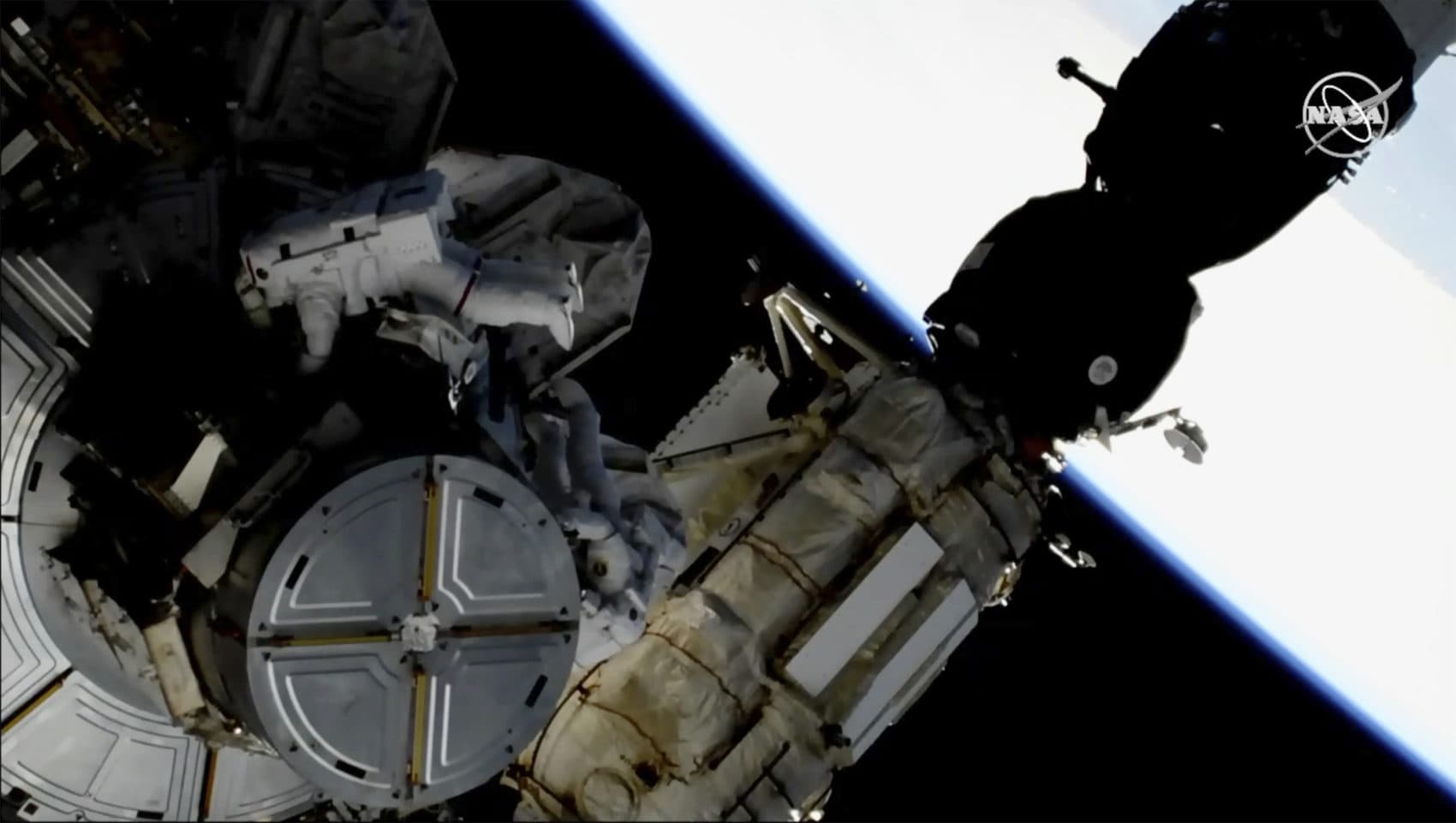Advertisement
After NASA Scraps First All-Female Spacewalk, Walk Goes Ahead — With One Man And One Woman

NASA scrapped plans for its first-ever all-female spacewalk earlier this week when astronaut Anne McClain realized the space station didn't have a prepared spacesuit that fit her. She needed a medium. The spacewalk went ahead Friday, though, with one man and one woman.
Twelve of NASA’s 38 active astronauts are women, and while spacesuits don’t come small-sized, Lindsay Aitchison, a former senior spacesuit engineer for NASA, says there are plans in the works to be more accommodating to the next generation of astronauts.
“That's actually been one of the drivers when we're looking at our next-generation spacesuits,” Aitchison tells Here & Now’s Peter O’Dowd. ‘We're trying to be more accommodating of all sizes not just females, but looking at the smaller end of the spectrum for males and females."
One of the products Aitchison says is being developed and tested in NASA’s neutral buoyancy lab is an adjustable upper torso component that can fit up to two different sizes within every unit. The new gear would make it so a “broader range of crew” could be included using less hardware.
Whether an all-female spacewalk is in the near future, though, Aitchison says, “It's definitely going to happen.”
“There's going to be a time for women to take spacewalks together as an all-female crew,” she says. “If you look at our most recent ASCAN [astronaut candidate] class, five of the 11 selectees were women. I think that's great, because everybody's going to have a role in space exploration as we go forward.”
Interview Highlights
On how NASA readies their spacesuits for use
“The way we design our spacesuits, they're a very modular system, and the reason we do that is that way we can have lots of different components, so you can mix and match. As our crews come up and down, they’re all different sizes and shapes.
“Having a modular system lets us have the most efficient set of options up there to size everybody appropriately. So, when we say we have two medium suits on space station, what we're really talking about is we have two medium upper torsos, and so, the upper torso is just one of about 12 different primary components that go into making your spacesuit.
“What needed to happen to enable to have two medium huts [hard upper torso assemblies] is that you take one that's already attached to a life support system — that's the suit that Anne used on her [first spacewalk] back on the 22nd. ... To get the second one up and running, you would have had to actually change out the upper torso on a suit that was already attached to a portable life support system, and you need to make sure that everything is done in a very precise order to make sure there are no leaks and everything is safe to go for your EVA [extravehicular activity].”
Advertisement
On the danger of going out into space with a suit that doesn’t fit right
“Anne actually has only done her first spacewalk, and that was in the medium. She did however do a lot of training in both the medium and the large size, and you never know which one is going to work out better for you until you're actually in space.
“The reason spacesuit fit is so important for you is that, if you think about, it is like any other piece of protective equipment that you're going to wear. Whether you're a soldier wearing ballistic protection or you're a firefighter in all of your gear, if it doesn't fit you well, it's not going to protect you well. And that's really important, because your spacesuit really is its own spacecraft. Everything that you have inside of the space station to protect you has to all be shrunk down and miniaturized perfectly to fit your body when you're outside doing your work.”
On how spacesuit engineers account for the fact that astronauts grow in space
“We never actually know how much any one individual is going to grow until they get to space. They can grow up to two inches, and that's mostly in their spine. So, the way that we account for that in our spacesuit design is we have adjustability throughout the waist and the torso length, and so, we make sure to have those sizing options available."
On what she thinks is the most fascinating piece of technology inside a NASA spacesuit
“There are a lot of different technologies that I think are pretty cool. When I look toward future technologies, things that I find really cool are we're looking at ways to incorporate going from having a checklist that's a physical book that's on your wrist to having a heads-up display inside of your spacesuit. So, technology that's going to allow you to have an augmented reality as you're working on a specific section of a space station or even building up a lunar surface habitat.
“It'd be projected inside of your helmet as opposed to having to have a physical book, and then that way, you can get a lot more interactive and have more information at your fingertips as it were.”
Marcelle Hutchins produced and edited this interview for broadcast with Todd Mundt. Jackson Cote adapted it for the web.
This segment aired on March 29, 2019.
